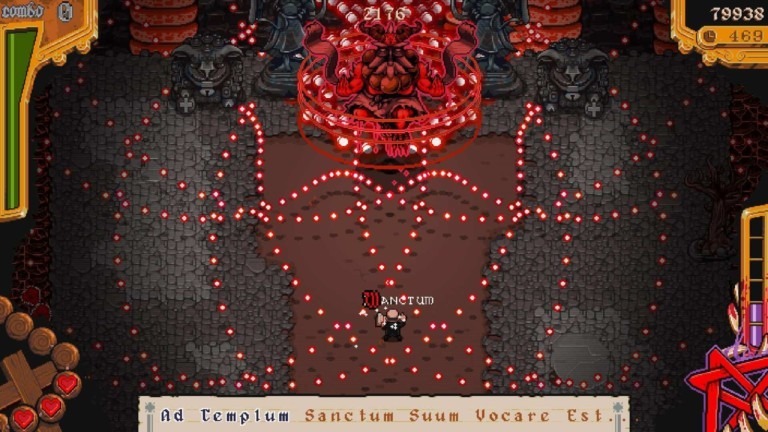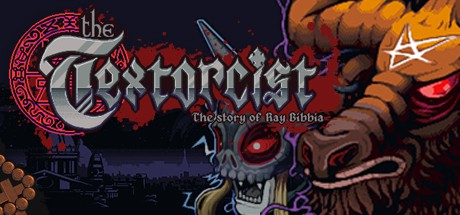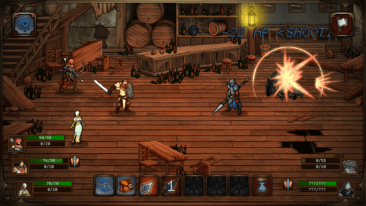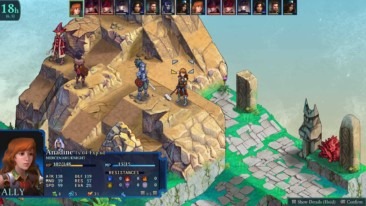The Textorcist: The Story of Ray Bibbia by Morbidware
When I think of The Textorcist: The Story of Ray Bibbia, I can’t help but think of what a joy it must have been for the developers to throw different influences together in such a cauldron of inventiveness. The game is packed with so many flourishes, ranging from aesthetic to mechanical, that they almost pass you by if you’re not paying close enough attention.
And attention is something of a premium within the frame of The Textorcist. Bullet hells usually demand quite a bit from players. This one is no different. But the Italian studio of Morbidware had the audacity to mix the bullet hell with a typing game.
As consumers of the holy bullet hell genre, we’re certainly benefiting from games like Enter the Gungeon, with its Roguelike elements, and Laser League, which made a competitive arena game out of the format. The Textorcist should be added to that list, as it does a great job of expanding what we think the bullet hell can be.
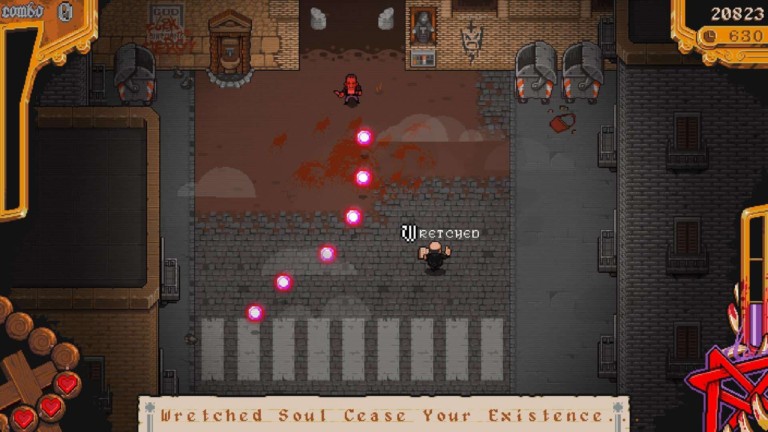
More Than Parody
The game follows the travels of Ray Bibbia, a private exorcist, answering the call of the needy in a Rome falling from something much worse than the Visigoths: demons are possessing folks, and Ray is called to mop up the vomit and chant Latin.
This all becomes part of a tale of occult corruption of the highest order at the Vatican, where demons have infiltrated the church. Though The Textorcist strikes a tone of humor and parody, there is something interesting about the content. It’s interesting because I firmly believe that artistic creation is reflective of the time and place in which the artist lived.
The game makes light of the Catholic church and occultism. It’s a fun theme to play around within a game about exorcising demons through typing. From an Italian studio, this may be what it was on the surface level, but reading the game as someone from Ireland, the game can take on new meaning.
For so long, repression and restriction have been a feature of a Catholic upbringing in Ireland. Dissension, critique and parody are relatively modern – in terms of the lifespan of the church – inventions when directed at Catholicism. There exists so much individual and collective trauma in Ireland because of systemic corruption that has manifested in sex scandals.
There is no room here to do the scale of this corruption justice, but we can mention how framing is important as a form of allegorical acknowledgement.
The mere framing of the Catholic Church as the antagonists is a rare occurrence in games. Outside of Final Fantasy X’s thematic lambasting of organised religion, it is not a topic often tackled. And I would argue that The Textorcist does not do this directly, but there is a case to be made for a wider socio-cultural acknowledgement in the Catholic Church’s corruption, which is represented in this game through occultist influences.
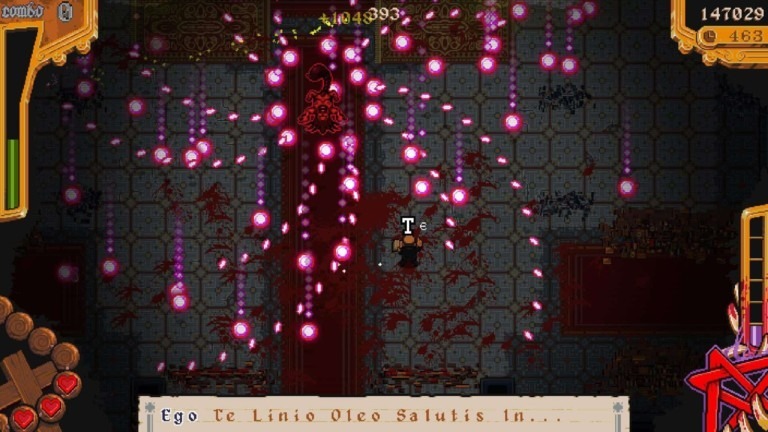
Exorcising Demons
The typing genre doesn’t have a long, storied history as bullet hells do, but when they land, they make an impact. The Typing of the Dead and Cook, Serve, Delicious! serve as almost solitary examples in a genre that is equal parts baffling and engrossing.
The Textorcist is no different, and its combination with bullet hell is well integrated both thematically and mechanically.
Instead of throwing several enemies simultaneously at the player, the game operates as a boss gauntlet. Mercifully, only one enemy at a time hurls demonic energy at the player. In return, the player will type out sentences that Ray reads from a bible, expelling his foe from the possessed body.
What the player is required to do then is quite tricky to get used to using the arrow keys to move out of the way of incoming fire and using the rest of the keyboard to spell out words which attack demons.
I’m sure you can see the problem manifesting – this is almost too much information to process at the same time, with your mind being split asunder in the effort.
But this is where Morbidware should be commended for how they have integrated the two. Unlike Enter the Gungeon which had so many random elements that struck me down, The Textorcist never feels out of reach. The patterns of bullets are never quite overwhelming, and there are enough breaks in between attacks to type out a word or two. The difficulty curve is managed well with more complicated patterns of bullets and unfamiliar Latin words that need to be typed out.
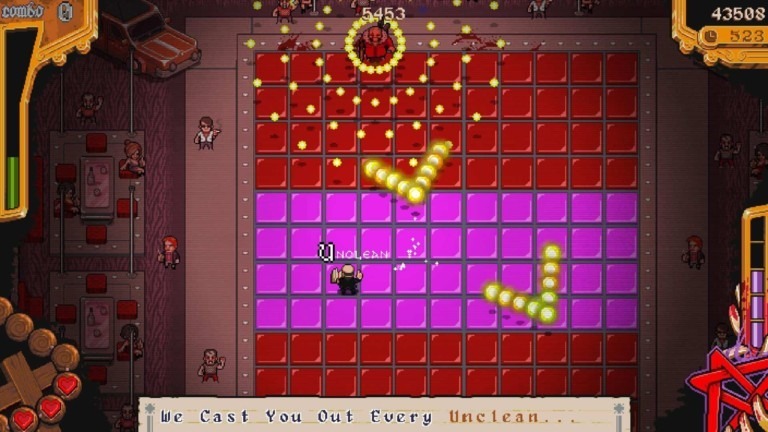
The double performance between the right hand on the arrow keys and left hand using the rest of the keyboard to type out attacks creates such a fresh approach that I can’t help but be effusive over it. This ambidextrous performance can be stressful, but it always feels attainable.
My only problem with it is a certain mechanic which wipes a little bit of progress from the player. If the player is hit, then they drop the bible. If they don’t collect it in time, then they will have to retype the sentence they were on.
Sometimes the bible gets thrown under the boss you’re fighting, which is a horrid way to fail a level, as the player will take damage on contact with them. Boss health regeneration never really feels fun for the player, but it is a mechanic which balances out how quickly players can run through these bosses.
But Why Is Naples…
As I’ve mentioned before there’s a wonderfully irreverent tone of parody throughout The Textorcist. The setting of Rome feels fresh, but it’s mixed in with pulp-noir tropes of heavy-drinking private investigators and shadowed New York streets that feel familiar from so many other pop culture examples.
There are also intertextual familiarities in the soundtrack which serve to playfully situate it within the ever-growing dexterity-based violence of so many EDM-fueled indie titles. With its top-down viewpoint and a pulsing soundtrack from GosT it echoes Hotline Miami for all the right reasons. Each level has a slow build up from the music which then blends straight into the action. It never interferes, it balances adroitly on the precipice between catchy and non-interference.
There’s some clever pixel art animation as well, from head-banging metalheads to floating demons that all help engross the player in this consistent idea of –
…
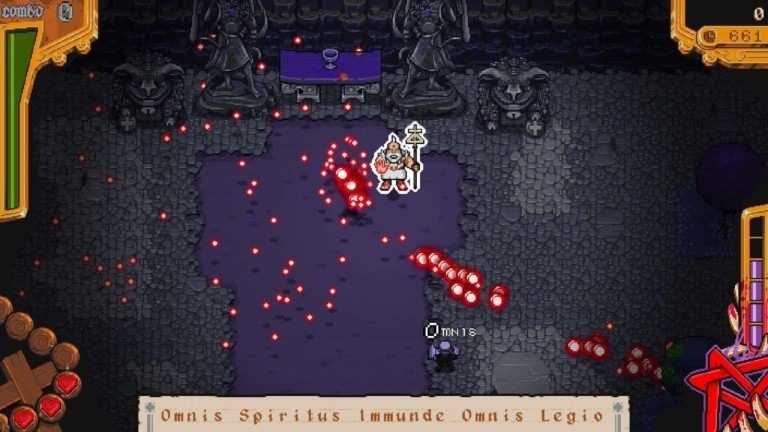
Why is Naples…Japanese?
I’ve gotten whiplash in this level where Ray takes a train from Rome to Naples to visit his master. Why are there cherry blossoms? Why are there Japanese kanji on signs in an Italian town? How long did that train from Rome to Naples take? NANDE???
I am bewildered, but pleasantly so. It doesn’t make any sense. There’s seemingly no reason for it. I’m sure there’s some in-game lore I’ve missed, but that’s a pretty huge chunk of lore surely.
The more I think about it in the context of this strange- mashup of a game the more I’m convinced it’s a loving, postmodern pastiche of the genre’s origins: of Japan lovingly bestowing upon the world danmaku (bullet hell) and the developers of Morbidware expanding our idea of what it could be. No matter what has been mashed together, the result is fresh and the framing is altogether important.
[xrr rating=”4/5″]
Get The Textorcist on Steam and GoG

